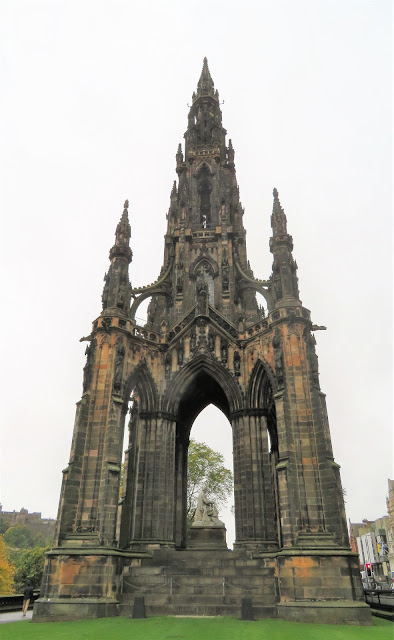We took the train from York to Edinburgh, enjoying views of the moist, green countryside along the way. Our hotel, once the British Royal Hotel, now an Indigo, was right across the street from the station. We checked in and then headed for the top of Calton Hill and its expansive views of the city and the Firth of Forth.
Calton Hill is known for its many monuments. The National Monument, an unfinished memorial to Scottish soldiers and sailors who were sacrificed in the Napoleonic Wars, was modeled on the Parthenon in Athens. Construction started in 1826, and ended in 1829, when funding ran out.
Atop the tower honoring Horatio Nelson is a time ball. In the past it was wired to a clock at the City Observatory, and was raised and lowered as a signal for ships to set their chronometers. The ball cannot be seen in fog, so in 1861, the One O'Clock Gun, a huge cannon, was installed at Edinburgh Castle to provide an audible signal. Today, the gun is still fired at 1:00pm, and the time ball is manually raised and lowered.
We visited the castle the next day, but we didn't hear the gun because at 1:00 pm we were deep inside, behind (or under) layers of thick stone walls.
The royal castle has been here since the early 1100s, and it has been expanded, remodeled, and restored extensively over the centuries. In the 16th century, this was the main gate.
The present entrance is fancier, flanked by statues and topped by the Latin phrase Nemo me impune lacessit (No one attacks me with impunity), the motto of the Royal Stuart dynasty. We saw this in many locations in town.

|

|
Just about everywhere we went, there was shop after shop specializing in cashmere, wool, kilts, sweaters, and tartan items of every type. We liked the bunnies.
Like nearly every city we have visited, Edinburgh is under construction.
New and updated buildings are important to the life of the city; at the same time, there is still great respect for historical structures, and the city is mindful of the visual appeal of traditional architecture. This Radisson hotel was built in 1992, but designed to fit in with the much older buildings on the street.
Gladstone's Land is a 500-year-old building. Built in 1550, it was renovated in 1620 to become the location of luxurious apartments. The gilded hawk over the entrance is a modern addition.
It is always refreshing to see monuments to artists, writers, scientists, and humanitarians in addition to the usual military and political figures. Edinburgh is proud of the many Scots who have made cultural contributions, and they are memorialized throughout the city.
Alexander Graham Bell, telephone innovator and founder of AT&T, was born here.
The Walter Scott memorial is 200 feet high. It is possible to get into one of the columns and climb 288 very narrow, winding steps to a viewing platform, but we didn't do that.
This statue of physicist James Clerk Maxwell was enhanced by a sidewalk plaque inscribed with his equations.
The Robert Burns monument was constructed in 1831. At some point, the marble statue of Burns was moved into a museum. The monument was extensively repaired and restored in 2009.
John Knox, founder of the Presbyterian Church of Scotland, is buried under the parking lot of St. Giles Cathedral, spot 23. The inscription reads, "The above stone marks the approximate site of the burial in St. Giles graveyard of John Knox, the great Scottish divine who died 24 Nov 1572".
Deacon William Brodie (1741-1788) led a double life. He was a respectable cabinet maker and City Councillor with a wife and family. But he was secretly a drinker and gambler who owed money to criminals and fathered five children with two mistresses. To meet all his obligations, and for fun, he became the head of a successful burglary gang. He was eventually captured and executed, buried in an unmarked grave in a church cemetery that is now, like the St. Giles graveyard, under a parking lot. Brodie was the inspiration for Robert Louis Stevenson's novel, The Strange Case of Dr. Jekyll and Mr Hyde.

|

|
Not every famous Scot is human. Dolly the sheep, the first mammal successfully cloned from an adult cell, died in 2003. Her body is preserved in the National Museum of Scotland.
Perhaps the most popular animal in Edinburgh is Greyfriars Bobby. This little terrier became famous for loyally guarding his master's grave in the Greyfriars churchyard for 14 years, until his own death in 1872. Bobby's story has been told many times in books and films. Many researchers believe the story is mostly myth, that Bobby, like many other churchyard dogs, was just a stray who stayed because he was fed by locals. Whatever the truth, people still find Bobby inspirational, and his statue and grave bring a lot of tourists to the area.

|

|
Having enjoyed a great week in Edinburgh, we hopped the train for Glasgow.






















No, don't tell me Grayfriar's Bobby is a myth!
ReplyDeleteThanks for this post, I am a big big fan of this website would like to keep
ReplyDeleteupdated.